Practice flipping the pencil from eraser end to tip end. Strength in their arm muscles trunk. fisted pencil grasp.
Fisted Pencil Grasp, This is typical of very young children. Between two and three years of age a childs pencil grasp will transition from the cylindrical grasp this fisted whole hand grasp into the radial cross. Gross motor milestones are a big focus as babies grow–but once kids are crawling cruising and climbing what comes next.
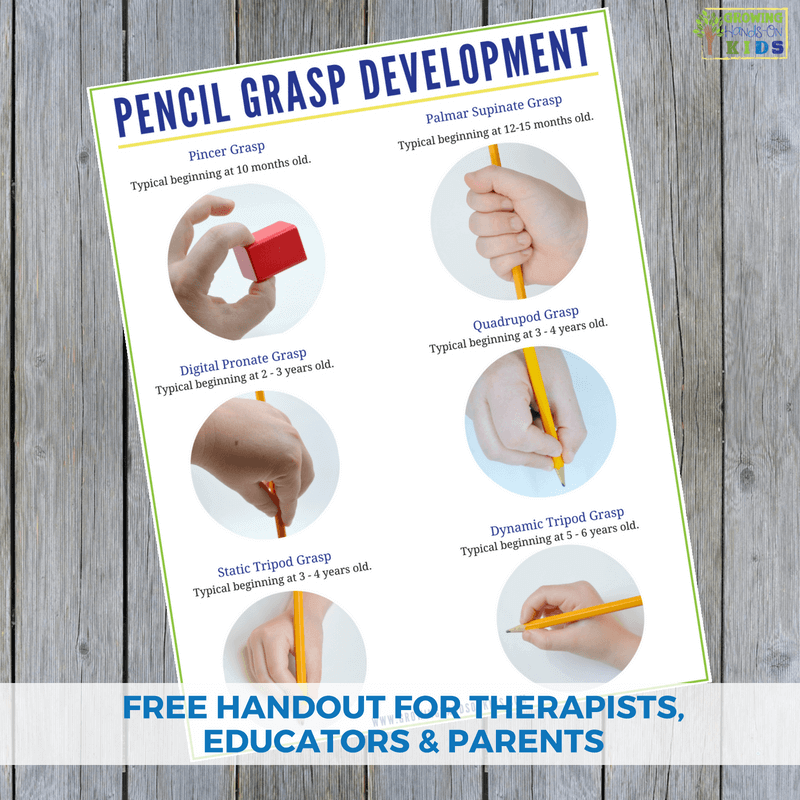 Typical Pencil Grasp Development For Kids From growinghandsonkids.com
Typical Pencil Grasp Development For Kids From growinghandsonkids.com
As the child develops more proximal stability ie. Fisted- grasp consists of fingers and thumb being wrapped around the pencil with the pencil being held in the vertical position. A Descriptive Model And 4 Empirical Studies dissertation.
At this stage toddlers are just getting used to holding on to a crayon chalk or marker and there is no precision in their drawings.
1- Write with short pencils or short crayon pieces for ten minutes or more every day. As the child develops more proximal stability ie. All fingers are holding the writing tool but the wrist is turned so that the palm is facing down towards the page. Pencil Grasp Development in Older Toddlers. Help Kids Develop a Functional Pencil Grasp with these 3 Daily Activities.
Another Article :
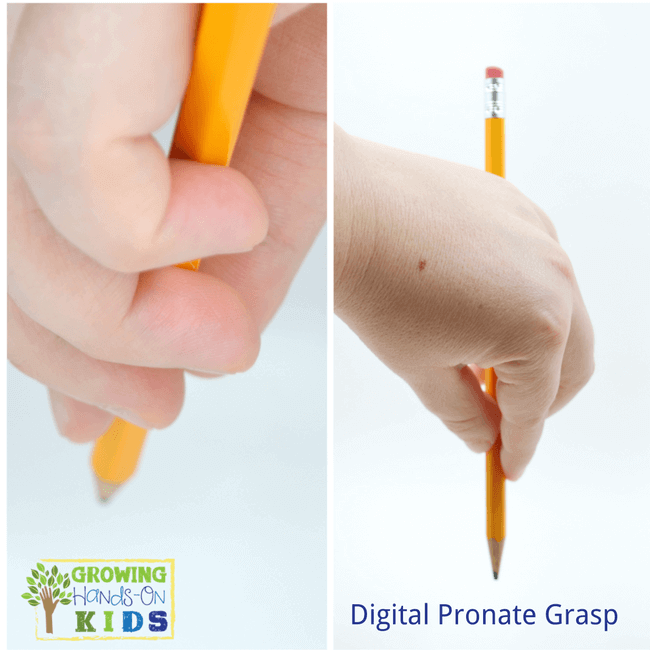 Source: growinghandsonkids.com
Source: growinghandsonkids.com
The pencil is held in a fisted hand with the point of the pencil on the fifth finger side on the hand. Most children will develop an efficient pencil grasp by using and mastering the following grasps. Most children will adopt a ideal tripod grip as this suites the structure of their hands. ISBN 951-765-130-9 ISBN 951-765-130-9. The thumb index and middle fingers are holding the pencil on the underside of the hand. But many children adopt an alternative grip especially children with hypermobile hand. Typical Pencil Grasp Development For Kids.
 Source: playdoughtoplato.com
Source: playdoughtoplato.com
Thumb Wrap- grasp consists of tight wrapping of the thumb around the pencil to try to increase grasp stability. Turn the pencil between the thumb and fingertips. This is typically around 1-1½ years of age. The fisted grip is exactly what it sounds like and is usually how a toddler initially grips a crayon or marker with the pinky side of the fist facing down. The short length encourages a better grasp so kids are using their fingers and thumb properly. The pencil is held in a fisted hand with the point of the pencil on the fifth finger side on the hand. Pencil Grasp Development In Babies And Toddlers.
 Source: youtube.com
Source: youtube.com
As the child progresses these four fingers may pull down to the tip of the finger into a quadrupod grasp. Kiddos using a this grasp will move the pencil or crayon around using their whole arm. The pencil is held in a fisted hand with the point of the pencil on the fifth finger side on the hand. At this stage toddlers are just getting used to holding on to a crayon chalk or marker and there is no precision in their drawings. Pencil Grasp Development in Older Toddlers. Writing Forces Associated With Four Pencil Grasp Patterns in Grade 4 Children AJOT March 2013 DOI. Pre Writing Skills Types Of Pencil Grasp Help 4 Special Youtube.
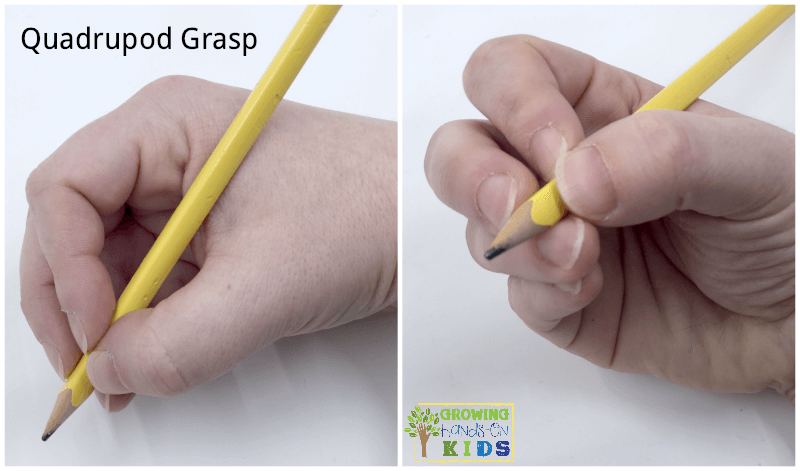 Source: growinghandsonkids.com
Source: growinghandsonkids.com
2- Have kids tuck a sponge under the pinky and ring fingers for one to five. 1- Write with short pencils or short crayon pieces for ten minutes or more every day. Fisted grip or Palmar Supinate Grip. With a fisted grip the movement is coming from the shoulders. This is a mature efficient pencil grasp. As the child develops more proximal stability ie. Typical Pencil Grasp Development For Kids.
 Source: stillplayingschool.com
Source: stillplayingschool.com
The first grasp pattern typically to develop around age 1 to 2 is the power or fisted grasp. The typical pattern of grasp development is shown in the image below. Children often hold their writing tool like a dagger scribbling using their whole arm. This is typically around 1-1½ years of age. The child continues with the same grasp pattern of pinching with thumb and index finger while resting the crayon marker or pencil on the knuckle of the middle finger. A pencil hold that provides. E S Pencil Grasp Still Playing School.
 Source: parenthub.com.au
Source: parenthub.com.au
Writing Forces Associated With Four Pencil Grasp Patterns in Grade 4 Children AJOT March 2013 DOI. Finally tomorrow I will share what a proper pencil grasp looks like and when parents should begin to worry about their childs pencil grasp. Gross motor milestones are a big focus as babies grow–but once kids are crawling cruising and climbing what comes next. The child continues with the same grasp pattern of pinching with thumb and index finger while resting the crayon marker or pencil on the knuckle of the middle finger. Most children will develop an efficient pencil grasp by using and mastering the following grasps. At this stage toddlers are just getting used to holding on to a crayon chalk or marker and there is no precision in their drawings. Developmental Milestones Toddlers Fine Motor Skills.
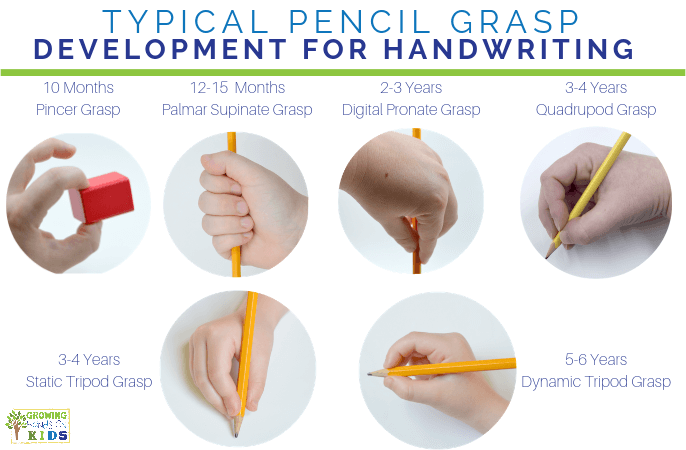 Source: growinghandsonkids.com
Source: growinghandsonkids.com
Stages of grip development. Its important to try to improve a childs pencil grasp earlier rather than later because the older they get the harder it will be to break their poor. The first grasp pattern typically to develop around age 1 to 2 is the power or fisted grasp. Fisted grip or Palmar Supinate Grip. But many children adopt an alternative grip especially children with hypermobile hand. At this stage toddlers are just getting used to holding on to a crayon chalk or marker and there is no precision in their drawings. Typical Pencil Grasp Development For Kids.
 Source: starfishtherapies.com
Source: starfishtherapies.com
When your child initially picks up a crayon heshe will most likely hold it in their closed fist. Help Kids Develop a Functional Pencil Grasp with these 3 Daily Activities. I love to share easy tricks to work on things like fine motor skills. Four Fingered Grasp- 35-4 years- Crayon is held between their thumb and tips of the pointer finger middle finger and ring finger. This is typical of very young children. In this grasp the pencil. Development Of Writing Utensil Grip.
 Source: growinghandsonkids.com
Source: growinghandsonkids.com
The first image displays the fisted grasp pattern which is typical for children under the age of 2 as toddlers use their whole arm to move the utensil to scribble. This is typical of very young children. Supporting the development of a childs pencil grip can be achieved by supporting them to develop the underlying skills required for manipulating a pencil properly such as grip strength finger isolation shoulder stability and postural control. At this stage toddlers are just getting used to holding on to a crayon chalk or marker and there is no precision in their drawings. The fisted grip is exactly what it sounds like and is usually how a toddler initially grips a crayon or marker with the pinky side of the fist facing down. However the pinky and ring fingers can now tuck themselves securely into the palm to stabilize the arch of the hand and the middle finger the wrist is consistently positioned in slight extension bent back. Typical Pencil Grasp Development For Kids.
 Source: allcaretherapygt.com
Source: allcaretherapygt.com
1- Write with short pencils or short crayon pieces for ten minutes or more every day. A good pencil graspgrip pattern allows the child to keep the wrist steady and make small movements of the fingers to move the pen tip in different direction to create short straight and curved lines. This is typical of very young children. Its important to try to improve a childs pencil grasp earlier rather than later because the older they get the harder it will be to break their poor. Your child will use movement from their shoulder whole-arm movements to scribble and colour. Functional Five Fingertip functional Thumb Wrap functional Fisted or Palmar non-functional This grasp is characterized by the pencil being held finger and thumb and resting on the middle finger. What Is Pencil Grasp Development.
 Source: sites.google.com
Source: sites.google.com
The fisted grip is exactly what it sounds like and is usually how a toddler initially grips a crayon or marker with the pinky side of the fist facing down. Fine motor coordination is how one learns to move smaller muscles of the hand and upper extremities in order to grasp release and manipulate toys and utensils. Finally tomorrow I will share what a proper pencil grasp looks like and when parents should begin to worry about their childs pencil grasp. Strength in their arm muscles trunk. As the child develops more proximal stability ie. The pencil is held in a fisted hand with the point of the pencil on the fifth finger side on the hand. Handwriting Grips Cammie Vodicka Occupational Therapist.
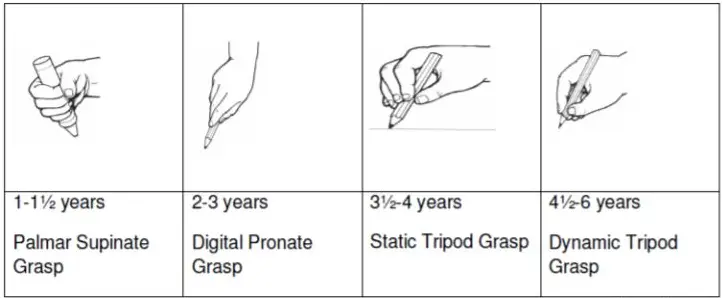 Source: kidsgrooveandgrow.com
Source: kidsgrooveandgrow.com
As the child develops more proximal stability ie. Its important to try to improve a childs pencil grasp earlier rather than later because the older they get the harder it will be to break their poor. 2- Have kids tuck a sponge under the pinky and ring fingers for one to five. The typical pattern of grasp development is shown in the image below. ISBN 951-765-130-9 ISBN 951-765-130-9. Help Kids Develop a Functional Pencil Grasp with these 3 Daily Activities. Teaching Correct Pencil Grip To Preschoolers Kidsgrooveandgrow Com.
 Source: stayathomeeducator.com
Source: stayathomeeducator.com
The thumb index and middle fingers are holding the pencil on the underside of the hand. The fisted grip is exactly what it sounds like and is usually how a toddler initially grips a crayon or marker with the pinky side of the fist facing down. At this stage toddlers are just getting used to holding on to a crayon chalk or marker and there is no precision in their drawings. The child continues with the same grasp pattern of pinching with thumb and index finger while resting the crayon marker or pencil on the knuckle of the middle finger. When your child initially picks up a crayon heshe will most likely hold it in their closed fist. The pencil is held diagonally within the hand with the tips of the thumb and index finger on the pencil. 5 Proven And Effective Tips For Teaching Pencil Grasp.
 Source: otconnectblog.wordpress.com
Source: otconnectblog.wordpress.com
Try turning it like a windmill in one direction then the other. Heres a quick guide of the appropriate development of pencil grasp and a fun resource with activities to improve your childs grasp. A Descriptive Model And 4 Empirical Studies dissertation. Their arm generally does not touch the table and they will. Children often hold their writing tool like a dagger scribbling using their whole arm. Most children will develop an efficient pencil grasp by using and mastering the following grasps. Pencil Grasp The Ot Buzz.
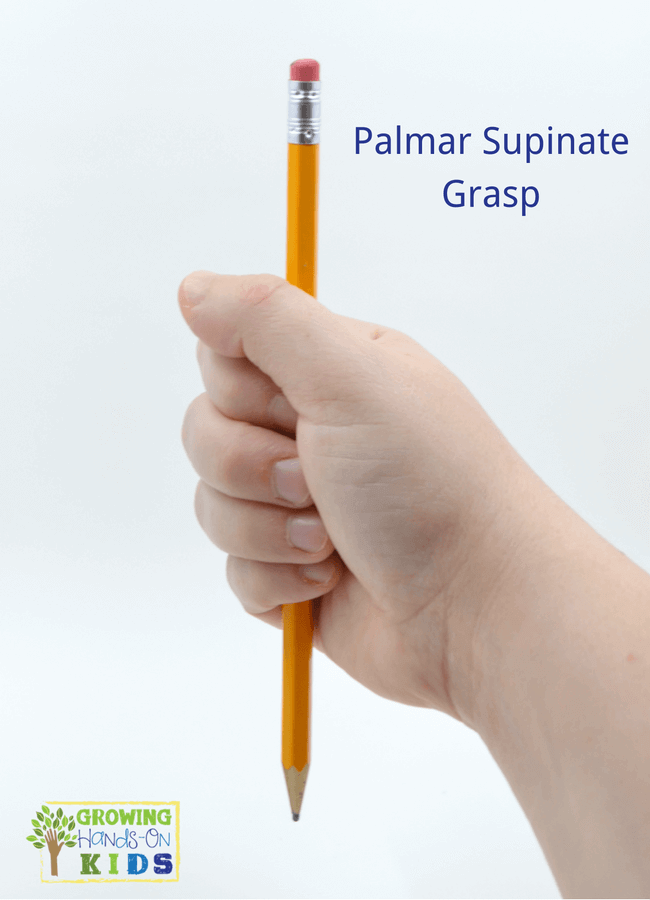 Source: growinghandsonkids.com
Source: growinghandsonkids.com
Heres a quick guide of the appropriate development of pencil grasp and a fun resource with activities to improve your childs grasp. In the palmar grasp the crayon lays across the palm with the thumb and pointer finger facing down. What is an efficient pencil grip. Four Fingered Grasp- 35-4 years- Crayon is held between their thumb and tips of the pointer finger middle finger and ring finger. This is typical of children ages 2 to 3. Heres a quick guide of the appropriate development of pencil grasp and a fun resource with activities to improve your childs grasp. Typical Pencil Grasp Development For Kids.

